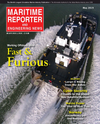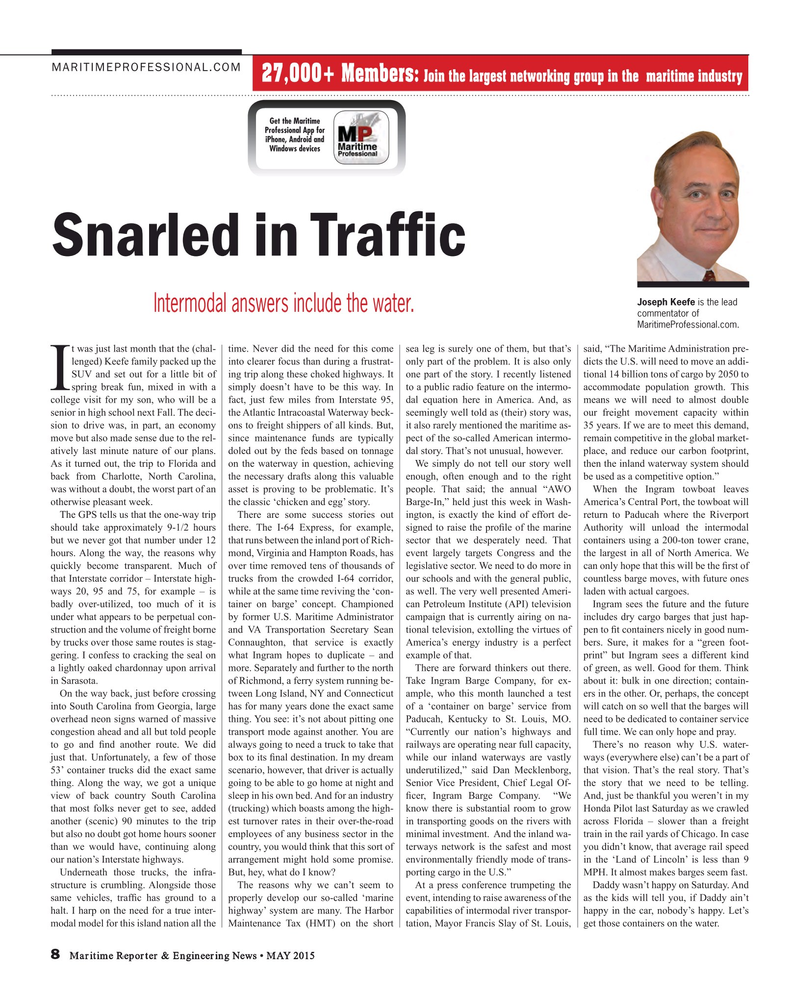
Page 8: of Maritime Reporter Magazine (May 2015)
The Marine Propulsion Edition
Read this page in Pdf, Flash or Html5 edition of May 2015 Maritime Reporter Magazine
MARITIMEPROFESSIONAL.COM 27,000+ Members: Join the largest networking group in the maritime industry
Get the Maritime
Professional App for iPhone, Android and
Windows devices
Snarled in Traf? c
Joseph Keefe is the lead
Intermodal answers include the water.
commentator of
MaritimeProfessional.com.
t was just last month that the (chal- time. Never did the need for this come sea leg is surely one of them, but that’s said, “The Maritime Administration pre- lenged) Keefe family packed up the into clearer focus than during a frustrat- only part of the problem. It is also only dicts the U.S. will need to move an addi-
SUV and set out for a little bit of ing trip along these choked highways. It one part of the story. I recently listened tional 14 billion tons of cargo by 2050 to
Ispring break fun, mixed in with a simply doesn’t have to be this way. In to a public radio feature on the intermo- accommodate population growth. This college visit for my son, who will be a fact, just few miles from Interstate 95, dal equation here in America. And, as means we will need to almost double senior in high school next Fall. The deci- the Atlantic Intracoastal Waterway beck- seemingly well told as (their) story was, our freight movement capacity within sion to drive was, in part, an economy ons to freight shippers of all kinds. But, it also rarely mentioned the maritime as- 35 years. If we are to meet this demand, move but also made sense due to the rel- since maintenance funds are typically pect of the so-called American intermo- remain competitive in the global market- atively last minute nature of our plans. doled out by the feds based on tonnage dal story. That’s not unusual, however. place, and reduce our carbon footprint,
As it turned out, the trip to Florida and on the waterway in question, achieving We simply do not tell our story well then the inland waterway system should back from Charlotte, North Carolina, the necessary drafts along this valuable enough, often enough and to the right be used as a competitive option.” was without a doubt, the worst part of an asset is proving to be problematic. It’s people. That said; the annual “AWO When the Ingram towboat leaves otherwise pleasant week. the classic ‘chicken and egg’ story. Barge-In,” held just this week in Wash- America’s Central Port, the towboat will
The GPS tells us that the one-way trip There are some success stories out ington, is exactly the kind of effort de- return to Paducah where the Riverport should take approximately 9-1/2 hours there. The I-64 Express, for example, signed to raise the pro? le of the marine Authority will unload the intermodal but we never got that number under 12 that runs between the inland port of Rich- sector that we desperately need. That containers using a 200-ton tower crane, hours. Along the way, the reasons why mond, Virginia and Hampton Roads, has event largely targets Congress and the the largest in all of North America. We quickly become transparent. Much of over time removed tens of thousands of legislative sector. We need to do more in can only hope that this will be the ? rst of that Interstate corridor – Interstate high- trucks from the crowded I-64 corridor, our schools and with the general public, countless barge moves, with future ones ways 20, 95 and 75, for example – is while at the same time reviving the ‘con- as well. The very well presented Ameri- laden with actual cargoes.
badly over-utilized, too much of it is tainer on barge’ concept. Championed can Petroleum Institute (API) television Ingram sees the future and the future under what appears to be perpetual con- by former U.S. Maritime Administrator campaign that is currently airing on na- includes dry cargo barges that just hap- struction and the volume of freight borne and VA Transportation Secretary Sean tional television, extolling the virtues of pen to ? t containers nicely in good num- by trucks over those same routes is stag- Connaughton, that service is exactly America’s energy industry is a perfect bers. Sure, it makes for a “green foot- gering. I confess to cracking the seal on what Ingram hopes to duplicate – and example of that. print” but Ingram sees a different kind a lightly oaked chardonnay upon arrival more. Separately and further to the north There are forward thinkers out there. of green, as well. Good for them. Think in Sarasota. of Richmond, a ferry system running be- Take Ingram Barge Company, for ex- about it: bulk in one direction; contain-
On the way back, just before crossing tween Long Island, NY and Connecticut ample, who this month launched a test ers in the other. Or, perhaps, the concept into South Carolina from Georgia, large has for many years done the exact same of a ‘container on barge’ service from will catch on so well that the barges will overhead neon signs warned of massive thing. You see: it’s not about pitting one Paducah, Kentucky to St. Louis, MO. need to be dedicated to container service congestion ahead and all but told people transport mode against another. You are “Currently our nation’s highways and full time. We can only hope and pray.
to go and ? nd another route. We did always going to need a truck to take that railways are operating near full capacity, There’s no reason why U.S. water- just that. Unfortunately, a few of those box to its ? nal destination. In my dream while our inland waterways are vastly ways (everywhere else) can’t be a part of 53’ container trucks did the exact same scenario, however, that driver is actually underutilized,” said Dan Mecklenborg, that vision. That’s the real story. That’s thing. Along the way, we got a unique going to be able to go home at night and Senior Vice President, Chief Legal Of- the story that we need to be telling. view of back country South Carolina sleep in his own bed. And for an industry ? cer, Ingram Barge Company. “We And, just be thankful you weren’t in my that most folks never get to see, added (trucking) which boasts among the high- know there is substantial room to grow Honda Pilot last Saturday as we crawled another (scenic) 90 minutes to the trip est turnover rates in their over-the-road in transporting goods on the rivers with across Florida – slower than a freight but also no doubt got home hours sooner employees of any business sector in the minimal investment. And the inland wa- train in the rail yards of Chicago. In case than we would have, continuing along country, you would think that this sort of terways network is the safest and most you didn’t know, that average rail speed our nation’s Interstate highways. arrangement might hold some promise. environmentally friendly mode of trans- in the ‘Land of Lincoln’ is less than 9
Underneath those trucks, the infra- But, hey, what do I know? porting cargo in the U.S.” MPH. It almost makes barges seem fast.
structure is crumbling. Alongside those The reasons why we can’t seem to At a press conference trumpeting the Daddy wasn’t happy on Saturday. And same vehicles, traf? c has ground to a properly develop our so-called ‘marine event, intending to raise awareness of the as the kids will tell you, if Daddy ain’t halt. I harp on the need for a true inter- highway’ system are many. The Harbor capabilities of intermodal river transpor- happy in the car, nobody’s happy. Let’s modal model for this island nation all the Maintenance Tax (HMT) on the short tation, Mayor Francis Slay of St. Louis, get those containers on the water. 8 Maritime Reporter & Engineering News • MAY 2015
MR #5 (1-9).indd 8 MR #5 (1-9).indd 8 5/7/2015 4:52:22 PM5/7/2015 4:52:22 PM

 7
7

 9
9
